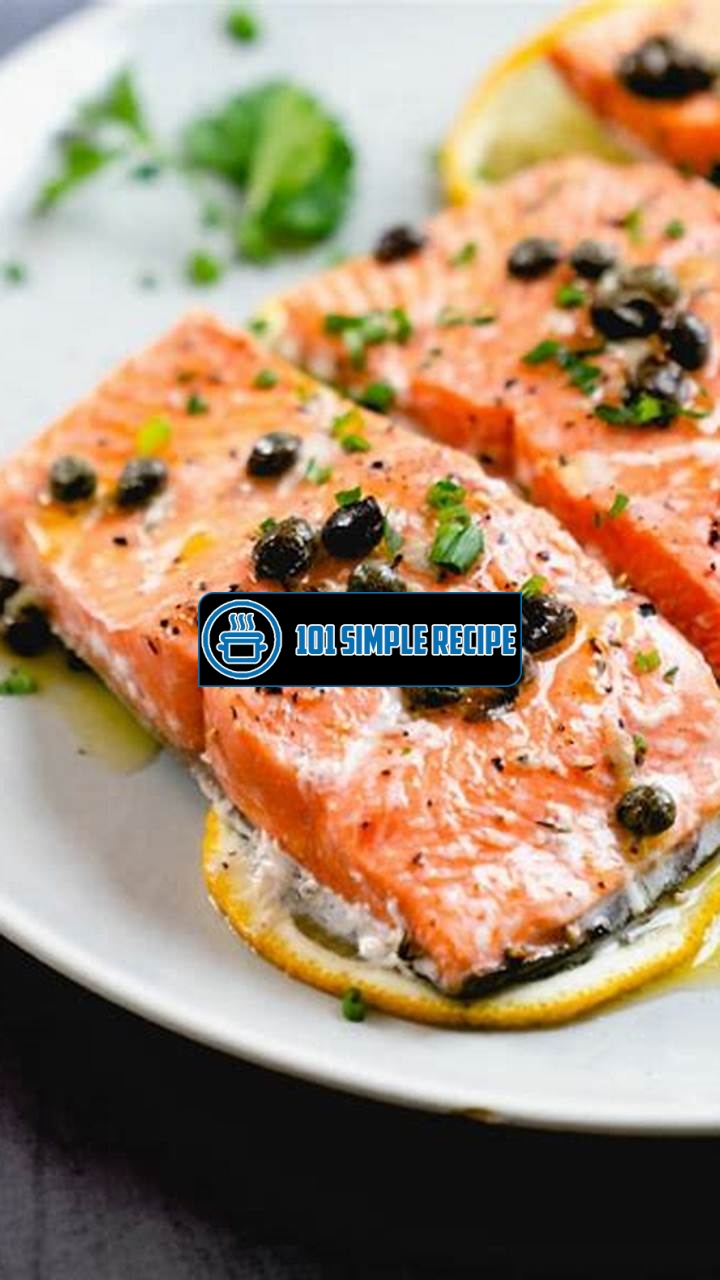Are you tired of dry and flavorless salmon? Say goodbye to disappointing meals and get ready to master the art of baking perfect salmon in the oven! With just a few simple steps, you can enjoy a moist, flavorful, and perfectly cooked piece of fish every time. Whether you’re a seasoned chef or a beginner in the kitchen, this guide will walk you through the process of preparing and baking salmon to culinary perfection. From selecting the freshest salmon fillets to mastering the ideal cooking time, we’ve got you covered. Say hello to deliciousness on your plate and impress your friends and family with your newfound salmon baking skills. So, let’s dive in and discover the secrets to baking the perfect salmon in the oven!

Understanding Different Types of Salmon
When it comes to baking salmon in the oven, understanding the different types of salmon available is key. Each type varies in taste and texture, allowing you to choose the perfect one for your palate. In this section, we will explore the three main types of salmon: Atlantic Salmon, Chinook Salmon, and Sockeye Salmon.
Atlantic Salmon
Atlantic Salmon, also known as Salmo salar, is one of the most popular types of salmon for baking. This species is native to the northern Atlantic Ocean and can range in color from pale pink to deep orange. Its flesh is known for its mild and delicate flavor, making it a favorite among seafood enthusiasts.
When baking Atlantic Salmon, it is important to keep in mind that this type of salmon has a higher fat content compared to other species. This fat helps to keep the fish moist and adds richness to its flavor. You can enhance the taste by using herbs, spices, and sauces to complement the natural flavors of the fish.
One important thing to note about Atlantic Salmon is its availability. Due to extensive fishing practices, the population of wild Atlantic Salmon has declined significantly. To ensure sustainability, it is recommended to choose farm-raised Atlantic Salmon, which is readily available in the market.
Chinook Salmon
Chinook Salmon, also known as Oncorhynchus tshawytscha, is the largest species of Pacific Salmon. It is known for its rich, buttery flavor and tender, flaky texture. When baked, Chinook Salmon retains its moistness and boasts a melt-in-your-mouth texture that seafood lovers crave.
This species of salmon is prized by both professional chefs and home cooks due to its exceptional taste. It is commonly referred to as “king salmon” because of its majestic size and premium quality. When selecting Chinook Salmon for baking, look for vibrant, firm flesh that has a deep orange color. This indicates freshness and ensures the best taste and texture.
Chinook Salmon can be baked using a variety of methods, including simple seasoning with salt and pepper or marinating with tangy citrus-infused sauces. The key is to let the natural flavors of the fish shine through, enhancing them with complementary ingredients.
Sockeye Salmon
Sockeye Salmon, scientifically known as Oncorhynchus nerka, is another popular choice for baking. With its deep red flesh and robust flavor, Sockeye Salmon offers a unique dining experience. When cooked, the flesh retains its vibrant color and firm texture, making it visually appealing and delightful to the palate.
When baking Sockeye Salmon, it is important to note that this species has a lower fat content compared to others, which leads to a slightly drier texture. To overcome this, marinating the fish prior to baking or basting it with butter or olive oil can help to add moisture and enhance the flavor.
Sockeye Salmon has a distinct taste that sets it apart from other varieties. Its flavor is often described as rich, earthy, and slightly nutty. To complement these flavors, you can choose to pair it with savory herbs or tangy lemon-based sauces.
In conclusion, mastering the art of baking perfect salmon in the oven begins with a thorough understanding of the different types of salmon available. Whether you prefer the mild and delicate flavor of Atlantic Salmon, the rich and buttery taste of Chinook Salmon, or the robust and vibrant experience of Sockeye Salmon, each type offers a unique dining experience. So next time you’re planning to bake salmon in the oven, consider the type of salmon that suits your taste preferences and get ready to create a culinary masterpiece.
Choosing the Perfect Salmon Fillet
When it comes to baking salmon in the oven, selecting the right fillet is key to achieving a dish that is bursting with flavor and maintains its high quality. Here are some important factors to consider before you make your purchase:
Fresh vs. Frozen Salmon
One of the first decisions you’ll need to make when choosing a salmon fillet is whether to opt for fresh or frozen. Both options have their benefits, so it ultimately depends on your personal preference and circumstances.
Fresh Salmon: If you have access to a reliable fish market or live near the coast, you may be able to find fresh salmon fillets. Fresh salmon is known for its vibrant color and succulent texture, as it hasn’t undergone freezing and maintains its natural moisture. It is ideal for those who prioritize a melt-in-your-mouth experience and prefer to enjoy the fish as soon as possible. Keep in mind that fresh salmon tends to have a shorter shelf life, so make sure to use it within a couple of days.
Frozen Salmon: On the other hand, frozen salmon is a convenient option that allows you to stock up and have fish readily available whenever you want it. Frozen salmon can still deliver excellent flavor and texture if handled and thawed properly. The freezing process helps preserve the nutritional value and freshness of the fish, making it a great alternative if you don’t have access to fresh salmon or prefer to plan your meals ahead of time. Just ensure that you thaw the fillet correctly before baking to avoid any loss of moisture.
Skin-On vs. Skin-Off
Another consideration when choosing a salmon fillet for baking is whether to go for skin-on or skin-off.
Skin-On Salmon: Opting for a fillet with the skin intact can provide additional flavor and help protect the delicate fish flesh during cooking. The skin acts as a natural barrier that helps retain moisture and imparts a delicious crispy texture when baked. It also makes it easier to handle the fillet while cooking, as the skin offers a non-stick surface. If you enjoy the taste and texture of crispy salmon skin, choosing a skin-on fillet is the way to go.
Skin-Off Salmon: For those who prefer a skinless fillet, there are plenty of options available in the market. Removing the skin can make the fillet more versatile in terms of cooking methods and allows for a more even seasoning. It also eliminates the need to deal with the sometimes-overpowering taste of the skin. If you prefer a more straightforward cooking process or have a specific recipe in mind that requires skinless fillets, choosing skin-off salmon is your best bet.
Sustainable Fishing Practices
Lastly, it is crucial to consider the sustainability factor when selecting a salmon fillet. Sustainable fishing practices ensure that the fish populations are not depleted and that the delicate marine ecosystem is protected.
Look for Labels: When purchasing salmon, keep an eye out for labels such as “MSC-certified” or “sustainably sourced.” These indicators mean that the fish has been responsibly caught or farmed and can help you make an eco-friendly choice.
Research and Support: Additionally, taking the time to research the brands and fisheries you are purchasing from can provide valuable insights into their fishing practices. Choose companies that implement measures to reduce bycatch and minimize the impact on the environment.
By considering the sustainability of your salmon selection, you can contribute to the protection of our oceans and make a positive difference.
Remember, when it comes to baking perfect salmon in the oven, the quality and characteristics of the fillet are vital. Whether you choose fresh or frozen, skin-on or skin-off, and prioritize sustainable fishing practices, your selection will greatly influence the taste and final result of your dish. So, make a mindful choice and savor the incredible flavors of well-prepared salmon!
How to Bake Salmon in the Oven
Prepping Your Salmon Fillet
Preparing your salmon fillet properly is the first step towards baking the perfect piece of fish in the oven. By following these essential steps, you can ensure that your salmon turns out moist, flavorful, and cooked to perfection.
Thawing Frozen Salmon
If you’re starting with frozen salmon, it’s important to thaw it properly before baking. Thawing the salmon in the refrigerator is the best method, as it allows for a slow and even thaw. Simply place the frozen salmon in a dish or tray and let it defrost in the fridge overnight. This will help preserve the integrity and texture of the fish.
Tip: Avoid thawing salmon at room temperature or with hot water, as this can lead to uneven thawing and potentially spoil the fish.
Removing Pin Bones
Prior to baking, it’s crucial to check for and remove any pin bones from your salmon fillet. Pin bones are small, thin bones that may be present in the flesh. To locate them, gently run your fingers along the fillet, feeling for any small protrusions. Once you’ve identified a pin bone, use a pair of clean kitchen tweezers or needle nose pliers to pull it out firmly and gently.
Tip: If you don’t have tweezers or pliers on hand, you can also use a small and sharp knife to carefully lift out the pin bones.
Seasoning and Marinating Options
Now that your salmon is thawed and free of pin bones, it’s time to add some flavor. Seasoning and marinating the fish can greatly enhance its taste and ensure a moist and delicious outcome. There are countless options when it comes to seasoning and marinating salmon, allowing you to personalize it according to your preferences.
Some popular seasoning options include:
- Citrus zest and herbs such as dill, thyme, or rosemary
- A blend of spices like paprika, garlic powder, and cayenne pepper
- Asian-inspired marinades with soy sauce, ginger, and sesame oil
To marinate your salmon, simply combine your chosen seasoning or marinade ingredients in a bowl or zip-top bag, then add the salmon fillet and let it soak for at least 30 minutes to overnight in the fridge. This allows the flavors to penetrate the fish and infuse it with deliciousness.
Tip: When marinating salmon, ensure that the fish is fully coated in the marinade and stored in an airtight container or bag to prevent any cross-contamination or moisture loss.
By following these prepping steps, you’ll be well on your way to baking the perfect salmon fillet in the oven. Remember, proper thawing, removing pin bones, and seasoning or marinating your salmon are key to achieving moist, flavorful, and delicious results. So go ahead and put your newfound knowledge into practice and enjoy a mouthwatering salmon dish that will impress your taste buds and guests!
Best Methods for Baking Salmon
When it comes to baking salmon in the oven, there are several techniques you can try to achieve the perfect level of doneness and flavor. Whether you prefer a classic preparation or want to experiment with different flavors, these methods will help you master the art of baking salmon.
Classic Baked Salmon
The classic method of baking salmon involves keeping it simple. Start by preheating your oven to 425°F (220°C). Line a baking dish with aluminum foil and lightly grease it to prevent the salmon from sticking. Place the salmon fillet, skin-side down, on the prepared baking dish. Season it with salt, pepper, and your choice of herbs or spices. You can use a combination of dill, lemon zest, garlic powder, or any other herbs and spices that you enjoy. Bake the salmon for about 12-15 minutes, or until it flakes easily with a fork. This method produces a tender and moist salmon with a mild flavor.
Herb-Crusted Salmon
If you want to add more flavor and texture to your baked salmon, try the herb-crusted method. Preheat your oven to 400°F (200°C) and line a baking sheet with parchment paper. In a bowl, combine breadcrumbs, chopped fresh herbs (such as parsley, thyme, and rosemary), minced garlic, and melted butter. Season the salmon fillet with salt and pepper, then spread the herb mixture evenly over the top. Gently press the mixture onto the salmon to help it adhere. Bake for 15-20 minutes, or until the crust is golden brown and the salmon is cooked through. This method adds a delightful crunch and a burst of herbaceous flavors to your salmon.
Glazed Salmon
For those who prefer a sweeter and more flavorful salmon, the glazed method is a great option. Preheat your oven to 375°F (190°C) and line a baking dish with aluminum foil. In a small saucepan, combine your choice of glaze ingredients, such as maple syrup, soy sauce, and Dijon mustard. Bring the mixture to a simmer over medium heat and cook until it thickens slightly. Place the salmon fillet in the prepared baking dish and brush the glaze over the top. Bake for 10-12 minutes, or until the salmon is cooked to your desired doneness and the glaze is caramelized. This method creates a sweet and savory salmon with a sticky glaze that will tantalize your taste buds.
By mastering these different methods for baking salmon in the oven, you will have a variety of delicious options to choose from. Whether you prefer the simplicity of classic baked salmon, the added crunch of herb-crusted salmon, or the sweetness of glazed salmon, you can easily satisfy your cravings. So, roll up your sleeves, grab your apron, and start baking your way to salmon perfection!
Tips for Perfectly Baked Salmon Every Time
When it comes to baking salmon in the oven, there are a few key tips and tricks you should keep in mind to ensure your fish turns out perfectly cooked every time. By avoiding common mistakes and following these guidelines, you can achieve exceptional results that will impress your family and friends.
Optimal Oven Temperature
The first step to baking perfect salmon is to set the oven to the optimal temperature. Preheat your oven to 425 degrees Fahrenheit (220 degrees Celsius) for the best results. This high temperature will help the salmon cook quickly and evenly, resulting in a deliciously moist and flaky texture.
Note: It is important to preheat the oven beforehand to ensure even cooking throughout the salmon fillet.
Monitoring Cooking Time
Another crucial aspect of baking salmon to perfection is monitoring the cooking time. The cooking time will vary depending on the thickness of your salmon fillet. As a general rule, you should allow for 10 minutes of cooking time per inch of thickness.
Note: It is essential not to overcook the salmon, as it can become dry and lose its delicate flavor. Keep a close eye on the cooking time to prevent this from happening.
If you are unsure about the thickness of your salmon fillet, you can measure it with a ruler or simply rely on your instinct. The flesh should feel firm to the touch and should flake easily with a fork when it is cooked through.
Testing for Doneness
To determine if your salmon is cooked to perfection, you can perform a simple test for doneness. Gently insert a fork into the thickest part of the salmon fillet and twist it slightly. If the flesh flakes easily and appears opaque, your salmon is ready to be enjoyed.
Note: If the salmon still appears translucent and doesn’t flake easily, it needs a few more minutes of baking time. Continue to monitor the cooking process and check for doneness again after a couple of minutes.
By mastering the art of baking salmon in the oven and following these tips and tricks, you can create a delicious and healthy meal that will impress even the most discerning palates. Enjoy!
Thank you for taking the time to read this article on how to bake salmon in the oven. We hope you found it informative and helpful. With these simple steps, you can now confidently prepare a delicious salmon dish for yourself and your loved ones. Whether it’s for a quick weeknight dinner or a special occasion, baking salmon in the oven is a versatile and flavorful option that is sure to impress. Remember to visit us again for more delicious recipes and cooking tips. Happy cooking!
Frequently Asked Questions
Here are some frequently asked questions about baking salmon in the oven:
| No. | Questions | Answers |
|---|---|---|
| 1 | What temperature should I set my oven to? | It is recommended to preheat your oven to 425°F (220°C) to bake salmon. |
| 2 | Should I use foil or parchment paper? | Using foil or parchment paper can help keep the salmon moist and prevent it from sticking to the baking sheet. It’s a personal preference, so you can choose whichever you prefer. |
| 3 | How long should I bake salmon for? | The general rule of thumb is to bake salmon for about 12-15 minutes per inch of thickness. However, cooking times may vary depending on the size and thickness of the salmon fillets. |
| 4 | Can I use different seasonings for the salmon? | Absolutely! You can experiment with different seasonings to suit your taste. Some popular options include garlic powder, lemon pepper, dill, and paprika. |
| 5 | How do I know if the salmon is cooked properly? | The salmon should appear opaque and easily flake with a fork when it is cooked. It should reach an internal temperature of 145°F (63°C). |
| 6 | Can I refrigerate leftovers? | Yes, you can refrigerate any leftover salmon in an airtight container for up to 3 days. It is recommended to consume leftovers within this timeframe. |
Closing Thoughts
Thank you once again for reading our guide on how to bake salmon in the oven. We hope you feel confident in your ability to create a delicious and healthy salmon dish. Whether it’s for a special occasion or a simple weeknight dinner, baking salmon is a versatile and tasty option. Don’t forget to visit us again for more great recipes and cooking tips. Happy baking!
Jump to Recipe
Baked Salmon in the Oven

Learn how to bake salmon in the oven with this easy recipe. Enjoy a flavorful and healthy dish that can be prepared in no time.
- 4 salmon fillets
- 2 tablespoons olive oil
- 1 teaspoon salt
- 1/2 teaspoon black pepper
- 1 teaspoon dried dill
- 1 lemon (sliced)
- Preheat your oven to 425°F (220°C).
- Place the salmon fillets on a baking sheet lined with foil or parchment paper. Drizzle the fillets with olive oil and season with salt, black pepper, and dried dill. Top each fillet with a slice of lemon.
- Bake the salmon in the preheated oven for 12-15 minutes, or until it is cooked through and flakes easily with a fork.
- Remove the salmon from the oven and let it rest for a few minutes. Serve hot and enjoy!






